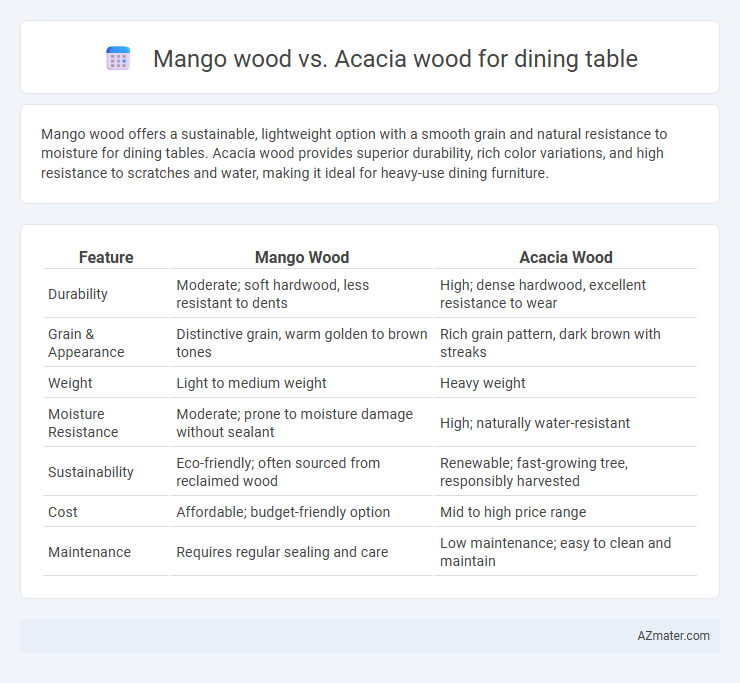Mango wood offers a sustainable, lightweight option with a smooth grain and natural resistance to moisture for dining tables. Acacia wood provides superior durability, rich color variations, and high resistance to scratches and water, making it ideal for heavy-use dining furniture.
Table of Comparison
| Feature | Mango Wood | Acacia Wood |
|---|---|---|
| Durability | Moderate; soft hardwood, less resistant to dents | High; dense hardwood, excellent resistance to wear |
| Grain & Appearance | Distinctive grain, warm golden to brown tones | Rich grain pattern, dark brown with streaks |
| Weight | Light to medium weight | Heavy weight |
| Moisture Resistance | Moderate; prone to moisture damage without sealant | High; naturally water-resistant |
| Sustainability | Eco-friendly; often sourced from reclaimed wood | Renewable; fast-growing tree, responsibly harvested |
| Cost | Affordable; budget-friendly option | Mid to high price range |
| Maintenance | Requires regular sealing and care | Low maintenance; easy to clean and maintain |
Introduction: Mango Wood vs Acacia Wood
Mango wood and Acacia wood are popular choices for dining tables due to their durability and aesthetic appeal. Mango wood is known for its sustainable sourcing and rich grain patterns that develop character over time. Acacia wood offers superior hardness and a natural resistance to scratches and moisture, making it ideal for high-traffic dining areas.
Overview of Mango Wood
Mango wood is a sustainable hardwood known for its durability and distinct grain patterns, making it an excellent choice for dining tables. It boasts natural resistance to moisture and warping, ensuring longevity in daily use environments. Compared to Acacia wood, Mango wood is often lighter and more affordable while maintaining a warm, rich aesthetic that enhances dining room decor.
Overview of Acacia Wood
Acacia wood is a durable, dense hardwood known for its rich grain patterns and natural resistance to water and pests, making it an excellent choice for dining tables. Its tight, fine grain and varied color tones range from golden to dark brown, enhancing the aesthetic appeal and uniqueness of each piece. Compared to mango wood, acacia offers superior hardness and longevity, ensuring a sturdy and long-lasting dining surface.
Durability and Strength Comparison
Mango wood offers moderate durability with a Janka hardness rating around 1,080, making it suitable for dining tables that experience light to medium use. Acacia wood boasts higher strength and durability, with a Janka hardness rating between 1,700 and 2,200, providing superior resistance to dents, scratches, and moisture, ideal for heavy-use dining tables. Both woods feature natural variations in grain and color, but acacia's denser structure ensures longer-lasting performance in high-traffic dining areas.
Appearance and Grain Differences
Mango wood features a lighter, golden-honey hue with a smooth, fine grain that often displays natural contrasting streaks, adding warmth and character to dining tables. In contrast, Acacia wood boasts a richer, darker brown tone with a pronounced, wavy grain pattern that creates a more dramatic and textured look. The subtle variations in Mango wood grain provide a softer, rustic aesthetic, while Acacia's bold grain makes it ideal for statement pieces with a striking visual impact.
Sustainability and Eco-Friendliness
Mango wood dining tables are highly sustainable due to the wood being harvested from mango trees that no longer produce fruit, reducing waste and promoting efficient resource use. Acacia wood, known for its fast growth and natural resistance to pests, offers an eco-friendly option by minimizing the need for chemical treatments and enabling quicker regeneration. Both woods provide durable, renewable choices, but mango wood often scores higher in sustainability due to its use of trees that might otherwise be discarded.
Maintenance and Care Requirements
Mango wood dining tables require moderate maintenance with regular dusting and occasional oiling to prevent drying and cracking, benefiting from its dense grain that resists warping. Acacia wood demands more frequent care, including sealing and polishing, to maintain its natural oils and prevent moisture damage due to its open grain texture. Both woods benefit from avoiding prolonged exposure to water and direct sunlight to preserve their durability and appearance over time.
Cost and Affordability
Mango wood dining tables are generally more affordable due to the wood's rapid growth and abundance, making it a cost-effective option for budget-conscious buyers. Acacia wood, while slightly more expensive, offers greater durability and natural resistance to wear, justifying its higher price point with long-term value. Both woods provide attractive grains and sturdy construction, but mango wood remains the preferred choice for economical dining furniture.
Best Uses for Dining Table Selection
Mango wood offers durability and a smooth finish with a rich, warm hue, making it ideal for rustic and modern dining tables that require longevity and low maintenance. Acacia wood boasts high density and natural resistance to moisture and scratches, perfectly suited for heavy-use dining tables in both indoor and semi-outdoor settings. Choosing between mango wood and acacia wood depends on desired aesthetics, durability needs, and environmental conditions in the dining area.
Conclusion: Which Wood is Better for Dining Tables?
Mango wood offers a dense, durable surface with a naturally rich grain, making it ideal for long-lasting dining tables that require minimal maintenance. Acacia wood excels in hardness and water resistance, providing robust, stylish tables that withstand daily wear and moisture better. For dining tables, Acacia wood is generally better due to its superior strength and resilience, especially in high-usage or humid environments.

Infographic: Mango wood vs Acacia wood for Dining Table
 azmater.com
azmater.com